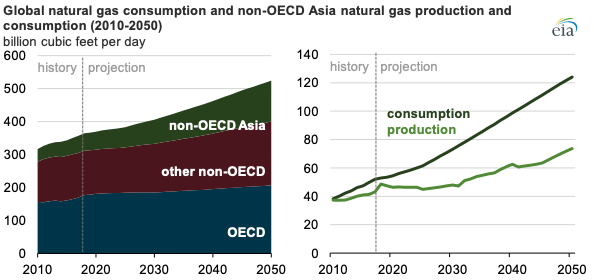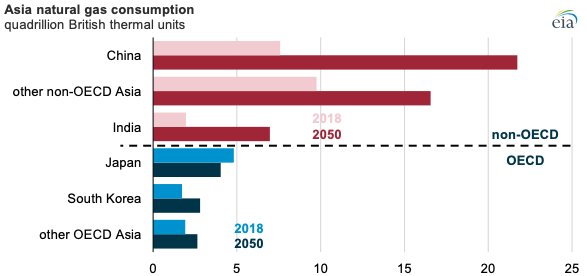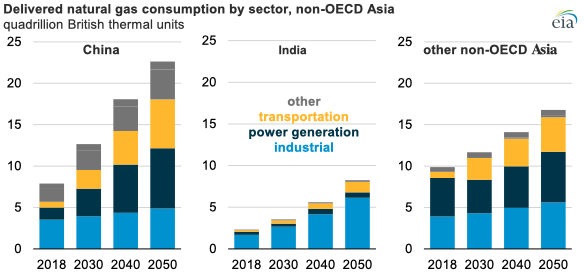According to the U.S. Energy Information Administration’s (EIA) latest International Energy Outlook 2019 (IEO2019) Reference case, future growth in natural gas consumption is concentrated in developing nations—those outside of the Organization for Economic Cooperation and Development (OECD)—especially in non-OECD Asian countries. Major non-OECD Asian countries include China, India, Bangladesh, Thailand, and Vietnam. EIA expects annual natural gas consumption in non-OECD Asia to reach 120 billion cubic feet per day (Bcf/d) by 2050, outpacing regional production by 50 Bcf/d. This supply imbalance widens through the projection period, resulting in non-OECD Asia’s increasing reliance on natural gas imports from other regions.

Non-OECD Asian countries account for almost half of projected global natural gas consumption growth from 2018 through 2050. Natural gas consumption in non-OECD Asia is largely driven by increased economic activity stemming from higher levels of consumer demand and industrial output.
China continues to be the largest natural gas consumer in non-OECD Asia: in 2050, EIA expects that China will consume nearly three times as much natural gas as it did in 2018. China’s projected increase in natural gas consumption is greater than the combined growth of natural gas consumption in all other non-OECD Asian countries.
EIA projects comparatively less natural gas demand growth in the developed economies of OECD Asia (Australia, Japan, New Zealand, and South Korea). EIA expects that natural gas consumption in Japan—currently the largest natural gas consumer in this group—will decrease slightly by 2050. OECD Asian countries are generally characterized as service-based economies with lower projected rates of population growth.

EIA expects natural gas consumption increases in China because of growth in the country’s electric power sector. This growth will result from both increased demand for electricity and from natural gas-fired power generation that displaces coal-fired units. During the IEO2019 projection period, EIA expects that natural gas consumption in China’s power generation sector will increase by a factor of four to reach 7.3 quadrillion British thermal units (Btu) in 2050. Energy-intensive urban areas such as the Beijing-Tianjin-Hebei metropolitan area and northeast China will favor natural gas-fired units and other sources of electricity that result in less air pollution compared with coal-fired units, according to IEO2019 Reference case results.

China’s transportation sector will also contribute to growth in natural gas consumption in the EIA forecast, driven mostly by increased natural gas demand in truck and rail freight transport. According to this view, natural gas consumption in China’s transportation sector will grow from less than 1 quadrillion Btu in 2018 to nearly 6 quadrillion Btu in 2050.
Increasing demand for natural gas in India is related to its increasing production of goods. Natural gas use in India’s industrial sector will surpass China’s industrial sector after 2040 and it will reach 6 quadrillion Btu by 2050, according to the IEO2019 Reference case. EIA expects India’s energy-intensive manufacturing to grow, especially the production of iron and steel, non-metallic minerals, and basic chemicals. EIA expects other countries in non-OECD Asia, such as Bangladesh, Thailand, and Vietnam, to experience a 30% increase in natural gas demand between 2018 and 2050 as a result of increased manufacturing.
EIA expects that the lack of low-cost natural gas resources in non-OECD Asia will contribute to a growing supply imbalance in the region. Although EIA expects non-OECD Asia natural gas production to more than double by 2050, the region’s natural gas consumption will grow faster. As a result, more natural gas imports will be required to satisfy demand.
Principal contributor: Steve Hanson

Follow us on social media: